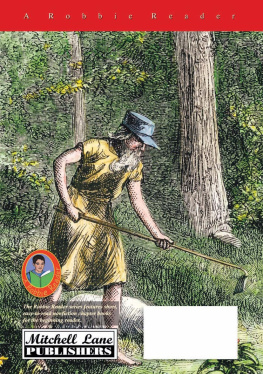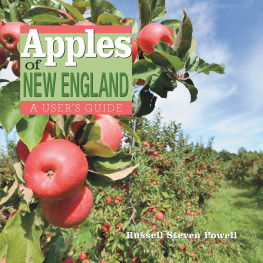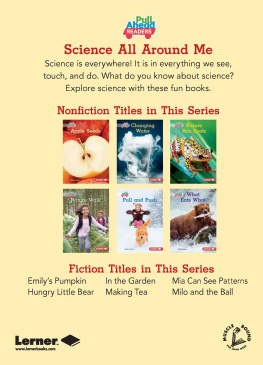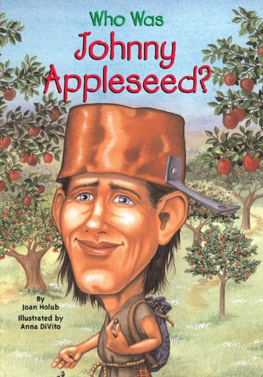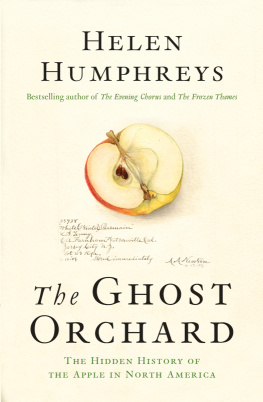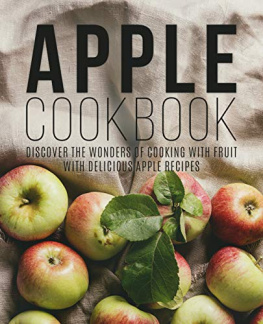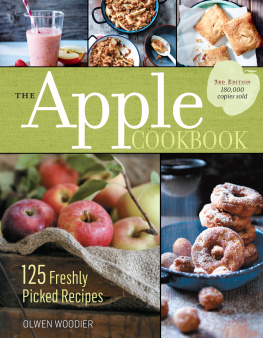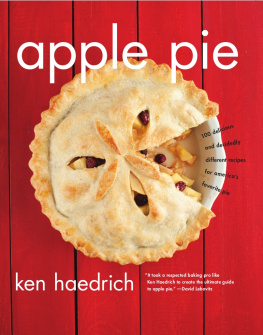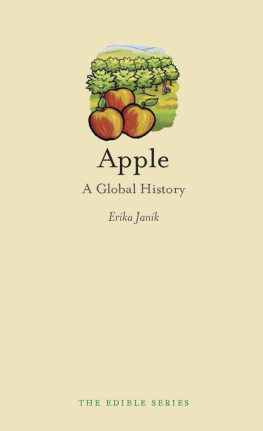


Copyright 2007 by Mitchell Lane Publishers. All rights reserved. No part of this book may be reproduced without written permission from the publisher. Printed and bound in the United States of America.
Printing 1 2 3 4 5 6 7 8 9
A Robbie Reader/Whats So Great About... ?
Annie Oakley
Ferdinand Magellan
Jacques Cartier
Sam Houston
Daniel Boone
Francis Scott Key
Johnny Appleseed
Davy Crockett
Henry Hudson
Robert Fulton
Library of Congress Cataloging-in-Publication Data
Zarzycki, Daryl Davis.
Johnny Appleseed / by Daryl Zarzycki.
p. cm. (A Robbie Reader. Whats so great about... ?)
Includes bibliographical references and index.
ISBN 1-58415-483-7 (library bound : alk. paper)
1. Appleseed, Johnny, 17741845Juvenile literature. 2. Apple growersUnited StatesBiographyJuvenile literature. 3. Frontier and pioneer lifeMiddle West Juvenile literature. I. Title. II. Series.
SB63.C46Z37 2006
634'.11092dc22
2005028505
ISBN-10: 1-58415-483-7
ISBN-13: 978-1-5841-5483-9
eISBN: 978-1-5457-5033-9
ABOUT THE AUTHOR: Daryl Davis Zarzycki is a second-grade teacher at Jennie Smith Elementary School in Newark, Delaware. She graduated from the University of Delaware with degrees in Elementary and Special Education. Her favorite subjects are science and math. And, of course, she loves to write. She has written Mia Hamm and Henry Ford for Mitchell Lane Publishers. She is married and has three grown children.
PHOTO CREDITS: Cover, pp. 12, 18North Wind Picture Archive; p. 8Barbara Marvis; p. 12Andreas Feininger/Time & Life Pictures/Getty Images; pp. 15, 16, 20, 27The Bettman Archive; p. 22Sharon Beck; p. 25The Sculpture Center; p. 26 Rodman Library.
PUBLISHERS NOTE: The following story has been thoroughly researched and to the best of our knowledge represents a true story. While every possible effort has been made to ensure accuracy, the publisher will not assume liability for damages caused by inaccuracies in the data, and makes no warranty on the accuracy of the information contained herein.
PLB
TABLE OF CONTENTS
Chapter One
A Perfect Day for Flying
Chapter Two
Old Wood and Rusty Wire
Chapter Three
A Plane as Yellow as a Sunflower
Chapter Four
Amelia the Famous Pilot
Chapter Five
What Happened to Amelia?
Words in bold type can be found in the glossary.

John Chapman planted apple seeds across the frontier. He traveled back and forth, planting new trees and then checking on the seedlings as they grew.

CHAPTER ONE
A Pioneer Planter
About 200 years ago, near the year 1800, John Chapman set out for the American West. He worked alone along the Ohio River, clearing land for planting. Johnny daydreamed about how this land would look in a few short years after the settlers came. He pictured orchards of apple trees and smiled. His work was important. It would provide the settlers with much-needed food and goods to trade.
Once the land was cleared and the soil was ready, Johnny dropped apple seeds into small holes he had dug in straight, neat rows. When the planting was done, he built a fence around the apple nursery (NUR-sree). The fence would protect the seedlings from hungry animals. Then Johnny moved on to another site and started all over. Johnny was a pioneer planter.
In the early 1800s, the United States looked very different than it does today. Most of the country was a wilderness of grassy plains and forests. Small colonies or towns had formed up and down the eastern part of the United States. A few cities were thriving as far west as Pittsburgh (PITS-berg), Pennsylvania (pen-sil-VAY-nya). There were few settlers living west of the mountains near Pittsburgh.
In time, the Northwest Territory became open for settlement. For a small price, pioneers could travel to this area and stake out land that would be theirs to own. The land was between the Ohio and Mississippi Rivers. It was rich and good for farming.
Slowly, pioneers arrived. Their trips through the wilderness were long and hard. They rode in covered wagons, bringing their families and all their belongings with them. Instead of roads, the pioneers traveled on Indian trails, which had not been made for wagons. Every evening, they stopped and set up camp. Most of the pioneers slept on the ground. Sleeping outdoors with the wild animals was dangerous.

John Chapman dreamed of planting apple seeds in the Northwest Territory (the dark blue area). He wanted the pioneers to have plenty of apples to eat. His travels would take him into the future states of Ohio (OH) and Indiana (IN).
John Chapman was one step ahead of these pioneers. He was one of the first to explore this new territory. He was there because he had a dream. He was going to plant apple seeds across the new frontier.
Stories spread of John Chapman, and people starting calling him Johnny Appleseed. As he quickly became a folk hero across the western frontier, stories of his adventures grew and grew. Some of the stories are true. Others are tall tales.

In the fall, when John Chapman was born, the leaves on many trees turn bright red, orange, and gold. The northeastern United States, including Johns home state of Massachusetts, is particularly famous for its fall colors.

CHAPTER TWO
John Chapman
September 26, 1774, was a beautiful autumn day in Leominster (LEH-mun-stur), Massachusetts. Juicy apples were ripe on the trees and ready for picking. Leaves were beginning to turn bright red, orange, and yellow. On this day, John Chapman was born.
Johns parents were Nathaniel and Elizabeth Chapman. Johns mother took care of him and his little sister, Elizabeth, while his father worked as both a farmer and a carpenter. His father tended crops and repaired farm equipment.
Johns first years of life were very sad. The Revolutionary (reh-voh-LOO-shuh-nay-ree) War had begun, and in 1776 Johns father was fighting against the British. By Johns second birthday, his mother had died.
In 1780, Johns father returned from the war and married again. The family moved to Longmeadow, Massachusetts. Over the next few years, their family grew and grew. John was the oldest of 12 children.
Near Johns home in Longmeadow, there was an apple orchard. In the fall, the family would pick apples. They kept them in their cool cellar so that they would have food for the winter. They made sauce, cider, vinegar, and butter from the apples. Johns favorite dish was apple pie.
Next page
